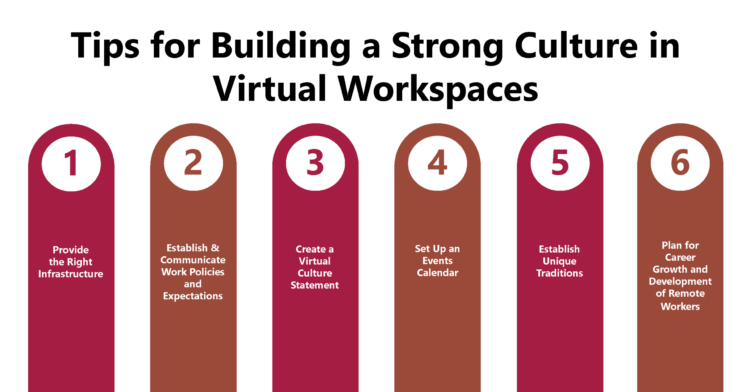1. Building a strong workplace culture in virtual environments requires addressing unique challenges, such as a lack of communication, ineffective traditional methods for culture-building, and difficulties in managing remote employees.
2. Organizations should provide the proper infrastructure, establish clear work policies, and create a virtual culture statement to help remote employees align with organizational values.
3. Setting up an events calendar and establishing unique traditions for virtual teams can foster connectivity, reduce isolation, and promote a sense of belonging among team members.
4. Planning for the career growth and development of remote employees ensures their engagement, motivation, and long-term commitment to the organization.
Organizations face a significant challenge in building a strong workplace culture for remote employees. Here’s a guide for building a workplace culture in virtual environments.

Simply speaking, virtual workspaces can be defined as a digital environment where employees of an organization interact and work together. They are not co-located physically.
However, employees who work remotely must integrate into the organizational culture.
So, it can ensure that these employees share the common values of the organization and are appropriately engaged.
It is a well-acknowledged fact that an organization’s culture plays a critical role in enhancing its success.
Most organizations have developed a well-defined organizational culture within their physical workspaces.
However, its integration into the newly developed virtual work environment is still a long journey.

There are several critical challenges faced by organizations to extend their culture into the digital work environment:
– A lack of proper communication among employees and between employees and their managers is one of the biggest challenges.
– Traditional culture-building initiatives in virtual environments might be ineffective in digital workspaces.
– In fact, cultural and ideological differences between employees are difficult to address in a virtual environment
– Also, most organizations lack the skills for managing remote employees effectively and building a virtual organizational culture effectively
Organizations must recognize that their virtual teams have needs that are similar to those of their physical teams.
However, the key difference lies in how these things are provided to them.
This fact can help them pave the way for building a solid organizational culture in a virtual environment.
Here are a few crucial guidelines that can be helpful for organizations in this context:
1. Provide the Right Infrastructure
2. Establish and Communicate Work Policies and Expectations
3. Create a Virtual Culture Statement
4. Set Up an Events Calendar
5. Establish Unique Traditions
6. Plan for Career Growth and Development of Remote Workers


As with physical teams, virtual employees should have the right infrastructure such as computers, furniture, and networks to work effectively.
Hence, organizations must provide this to their virtual teams.
If the organization cannot provide the infrastructure, it should finance the employees’ arrangements.

Also, organizations need to establish and communicate their work policies and expectations to their virtual teams.
Hence, organizations should ensure that these policies and expectations align with the business’s operating philosophies.
So, the culture would reflect the corporate values of the organization.
It would also ensure that the virtual teams are integral to the organization.

Organizations often fail to provide remote working teams with a clear virtual culture statement.
However, such a statement helps virtual teams to relate to their work environment and keep them engaged and motivated.
Therefore, such a statement should include the organization’s core values and explain how remote employees can align their actions and behaviors accordingly.

Additionally, an events calendar featuring virtual meetups, recognition events, happy hours, brainstorming sessions, and more is essential for fostering a strong culture.
Such an events calendar provides the virtual teams with a firm sense of time and connectivity with their team members.
Hence, it provides them with the opportunity to meet and interact with team members virtually, thereby eliminating the sense of isolation.

Just like physical workspaces, the culture of virtual office environments should be defined by some unique traditions.
Such traditions enable virtual team members to interact freely, work flexibly, or set aside time for informal discussions.

Personal growth and development of remote-working employees are among their significant areas of concern.
Hence, organizations need to plan for the career growth and development of members of their virtual teams.
Therefore, they need to invest in the skill development and professional growth of these remote employees, aligning it with their career objectives.
As the demand for digital workspaces continues to grow, organizations can benefit greatly by considering this guide for building workplace culture in virtual environments to enhance their profitability and business success.

Lead author: Sagar Chaudhuri, the Co-Founder and CEO of HiFives. He is an HR Tech Evangelist with over 25 years of experience in both corporate and entrepreneurial settings. Previously, Sagar has held leadership roles with companies such as Genpact, Infosys, and ICICI Bank. He has an engineering degree from IIT Kharagpur and an MBA from IIM Lucknow. Connect on LinkedIn
To stay updated on the latest HiFives blogs, follow us on Twitter (@MyHiFives)